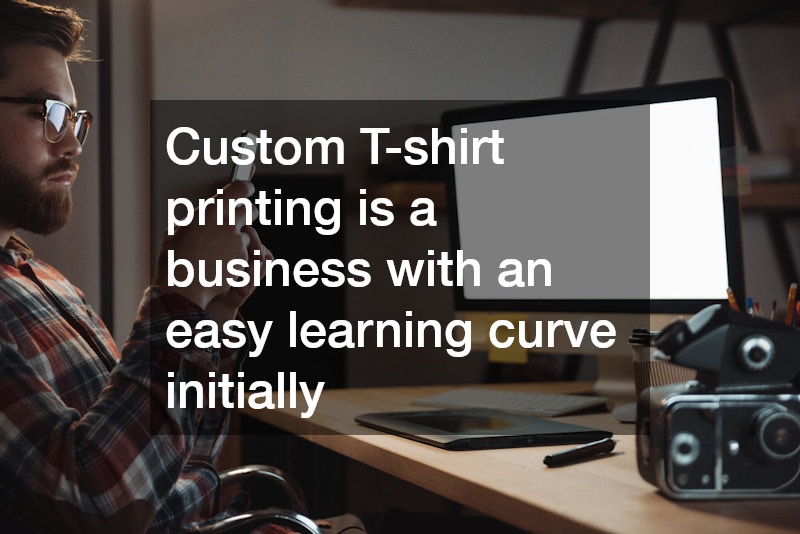
If you want to open a business where you can provide popular, personalized gifts for everyone on your holiday list, you may decide to begin offering personalized T-shirts. Custom-printed accessories, including T-shirts, are popular with businesses, political campaigns, and groups traveling together. Many families that travel together enjoy buying personalized T-shirts for family outings such as family reunions.
According to Business Guru, the biggest expense in opening a T-shirt business will be the equipment, including a printer or heat press. Your start-up costs will include licensing costs, a graphic design computer, and a starting supply of blank shirts, inks, and transfer paper. Most new businesses will begin with a small supply of T-shirts, so your starting costs will be proportionally long.

Custom T-shirt printing is a business with an easy learning curve initially. One of the most interesting facts about this type of business is that fully printed shirts require the same effort as T-shirts with a single-letter monogram. As your company begins to build in popularity, you will soon see that even bulk T-shirt orders don’t require that much effort, except for sorting and shipping activities.
Did you know that the US is the largest apparel market in the world? In 2016 alone, the value of apparel bought exceeded $300 billion.
A considerable proportion of apparel sales come from custom printed t-shirts. Businesses use custom t-shirts to create awareness about their brand and for marketing. For individuals, custom t-shirts are the perfect way for people to wear their thoughts and stand out. Also, custom t-shirts are powerful tools for showing unity and loyalty among political, religious, or sporting groups.
Therefore, the demand for t-shirt printing services is high and projected to rise over the coming years. Are you thinking of starting a t-shirt printing venture, or you are already in the industry looking to scale up? This guide will teach you all you need to know when buying an automatic heat press for the best custom transfers.
Why Use a Heat Press Machine?
When it comes to the printing business, there is a huge demand for other items such as caps, bags, cups, mouse-pads, canvas tote bags, ceramic plates, and tiles, among many other things.
Automatic heat presses allow you to make custom transfers on a wide range of products and materials. Therefore, you will be able to capitalize on all aspects of clients’ printing needs.
Which Heat Press Machine Suits Your Needs?
Though heat presses primarily serve the same purpose, there are some variations between one machine and the next. There are several things to consider when choosing a multi-purpose heat press. They are:
Size
The size of your heat press machine will dictate the size of custom transfers it is capable of handling. Bigger machines will allow you to produce bigger designs. However, as you weigh the size options, consider the jobs you will handle and the size of your business. The machine should not be too big if you receive small quantity orders or too small to manage your workload.
Generally, the sizes are:
- Very small/label presses- These machines are usually 4″ x 6″ to 6″ x 8″ and are suitable for printing small items like baby clothes.
- Small Presses- They range from 9″ x 12″ to 12″ x 14″ and are suitable for one-off prints and short production runs.
- Medium Presses- The sizes range from 14″ x 16″ to 16″ x 16″ and are suitable for long printing runs.
- Large presses- These are 16″ x 20″ and larger. They are usually used for print jobs with large designs.
Type
Heat press machines come in two main types. The clam type and swing-away type.
The top platen of swing-away types lifts straight up and swings to the right, and most platens can rotate about 100 degrees. On the other hand, clam the platens on clamshell presses lift straight up to open completely. This allows the user to slide the bottom platen outwards toward them.
Analog or Digital
The key to durable custom transfer applications is accurate temperature and duration of press. Heat press machines with digital functions are more accurate and user-friendly. When it comes to temperature, consider the following:
- Type of temperature gauge the heat press uses.
- The spacing of the heating elements inside the press to reduce cold spots.
- The thickness of the heat press platen as thin ones lose heat quicker.
- Maximum heat it can produce as some custom transfers require up to 400 degrees.
- Amount of time required for the press to heat up.
Another factor to consider is the pressure the heat press will apply to the substrate and material. The pressure can be light, medium, or heavy and must be applied evenly and at the right amounts. To test for even pressure, place a square piece of paper on each of the four corners, and close the press. If you try to pull out the papers, they should offer equal resistance if the pressure is distributed equally.
In Conclusion
Though the demand for printed t-shirts and accessories is high, the success of your venture heavily relies on the quality of printing you offer. With an automatic heat press, you will be able to do high-quality custom transfers that will make clients keep coming back.
